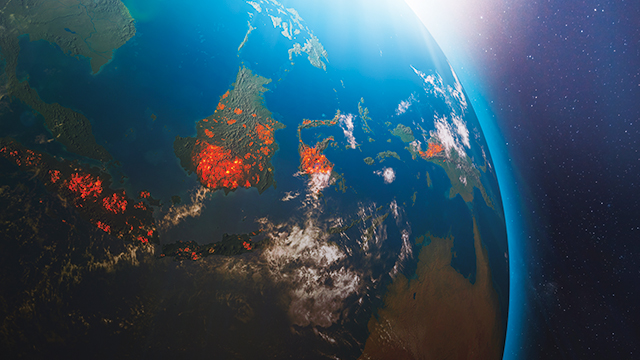Jakarta (Greeners) – The Meteorology, Climatology, and Geophysics Agency (BMKG) asserts that land and forest fires affect the ozone layer’s condition. Fires release smoke with organic compounds into the atmosphere. This compound lasts a long time, worsen ozone depletion. Other factors, such as the climate crisis, are also causing the thinning of the ultraviolet radiation-resistant layer.
“Land and forest fires worsen the condition of the ozone layer. However, the corona pandemic has reduced human activity. It automatically helps the process of restoring the ozonosphere,” says Kadarsah, Head of BMKG Climate Change Analysis, to Greeners (21/09/2020).
According to the Global Atmospheric Watch (GAW) Bukit Kototabang, West Sumatra, Kadarsah continues, BMKG notes that ozone concentrations increased in August. Kadarsah argues, the increase in ozone depletion is possibly due to hotspots in some locations.
“Hotspot in August is very high. There is a possibility that it affects the ozone layer. However, it still needs to be investigated,” she explains.
Further, Kadarsah mentions the catastrophic fires had prompted a giant pyrocumulonimbus cloud that could last for months and destroy the ozonosphere. Additionally, fires also produce hydrochlorofluorocarbons (HCFCs) or freons that can perforate the ozone layer.
“Forest fires also release methane gas, a greenhouse gas that is twenty-one times more toxic than carbon dioxide. This compound is harmful to ozone,” she adds.
Also read: Indigenous Community Demands Local Regulation to Claim Customary Forests

Konsentrasi harian ozon pada Agustus 2020 di Stasiun Pemantau Atmosfer Global (GAW) Bukit Kototabang, Sumatera Barat. Sumber: Badan Meteorologi, Klimatologi, dan Geofisika (BMKG).
Climate Crisis Aggravates the Ozone Depletion
Program Director of Alam Sehat Lestari Foundation (ASRI), Mahardhika Putra Purba, affirms that the climate crisis aggravates the ozone depletion.
“Some factors that cause climate change are namely mining, industry, agriculture, transportation, and fires,” Purba says on a conference talk Rawat Bumi yang Merawat Kita (Caring the Earth that Cares for Us), Wednesday (16/9).
He said the stratosphere’s ozone layer serves as a barrier between Earth and the sun’s ultraviolet rays. Currently, the ozone condition is running low due to chlorofluorocarbons (CFC) in the form of chlorine, fluorine, carbon, and aerosols.
“CFC gas is dangerous because it is durable. It is also damages the environment quickly,” he explains.
When fluorine is exposed to sunlight, he continues, the compound will separate from its molecular structure. As a result, other compounds such as chlorine forms a new reaction with oxygen and separate ozone from each other.
“When ozone, which consists of three oxygens, releases one of the oxygens, the chlorine forms a reaction with oxygen that will last a long time and causes the ozone layer to become thin,” he said.
Also read: NGO: Hotspots Increase over Two Decades
MontiR-AC: Effort to Reduce the Ozone Depletion
Meanwhile, in commemoration of International Ozone Day 2020, the Ministry of Environment and Forestry (KLHK) signed a certification scheme for refrigeration and air conditioning technicians. In the Ozone for a Life event (16/9), the government launched MontiR-AC. MontiR-AC is an application that helps technicians to find air conditioners servicing’s gigs easier. This app also allows consumers to find competent technicians in their neighborhood easily.
“Preparing competent Refrigeration and Air Conditioner (RAC) technicians is an effort to reduce ozone depletion,” said KLHK Director General of Climate Change Control Ruandha Agung Sugardiman.
According to him, these efforts will help technicians to service RAC properly. It can also avoid the release of refrigerant into the air, which results in the depletion ozonosphere. By performing the correct service, Sugadirman continues, machine life can be prolonged. Eventually, it will save energy consumption from the equipment.
Author: Maria Soterini
Editor: Devi Anggar Oktaviani/Ixora Devi (Eng.)


















































